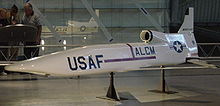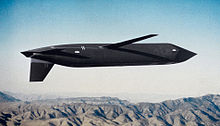Cruise missile designs fundamentally derive from the German V-1 of World War II. Advances in transistor and computer technology allowed self-correcting avionic and aeronautical designs that allowed missiles to be guided in flight, as opposed to only at launch. These advances developed into guided missiles and guided bombs, and later into the modern cruise missile.
Contents
|
History

A Fieseler Fi-103, the German V-1.
Germany first deployed cruise style missiles, during World War II. The V-1 contained a gyroscopic guidance system and was propelled by a simple pulse-jet engine, the sound of which gave it the nickname of "buzz bomb". Accuracy was sufficient only for use against very large targets (the general area of a city). The V-1 and similar early weapons are often referred to as flying bombs.
Immediately after the war the United States Air Force had 21 different guided missile projects including would-be cruise missiles. All were cancelled by 1948 except four: the Air Material Command BANSHEE, the SM-62 Snark, the SM-64 Navaho, and the MGM-1 Matador. The BANSHEE design was similar to Operation Aphrodite; like Aphrodite it failed, and was canceled in April 1949.[1]
During the Cold War period both the United States and the Soviet Union experimented further with the concept, deploying early cruise missiles from land, submarines and aircraft. The main outcome of the U.S. Navy submarine missile project was the SSM-N-8 Regulus missile, based upon the V-1.
The U.S. Air Force's first operational surface-to-surface missile was the winged, mobile, nuclear-capable MGM-1 Matador, also similar in concept to the V-1. Deployment overseas began in 1954, first to West Germany and later to the Republic of China (Taiwan) and South Korea. On November 7, 1956 U. S. Air Force Matador units in West Germany, whose missiles were capable of striking targets in the Warsaw Pact, deployed from their fixed day-to-day sites to unannounced dispersed launch locations. This alert was in response to the crisis posed by the Soviet attack on Hungary which suppressed the 1956 Hungarian Revolution.
Between 1957 and 1961 the United States followed an ambitious and well-funded program to develop a nuclear-powered cruise missile, Project Pluto. It was designed to fly below the enemy's radar at speeds above Mach 3 and carry a number of hydrogen bombs that it would drop on its path over enemy territory. Although the concept was proven sound and the 500 megawatt engine finished a successful test run in 1961, no airworthy device was ever completed. The project was finally abandoned in favor of ICBM development.
While ballistic missiles were the preferred weapons for land targets, heavy nuclear and conventional tipped cruise missiles were seen by the USSR as a primary weapon to destroy U.S. naval carrier battle groups. Large submarines (e.g. Echo and Oscar classes) were developed to carry these weapons and shadow U.S. battle groups at sea, and large bombers (e.g. Backfire, Bear, and Blackjack models) were equipped with the weapons in their air-launched cruise missile (ALCM) configuration.
General design
Cruise missiles generally consist of a guidance system, payload, and propulsion system, housed in an airframe with small wings and empennage for flight control. Payloads usually consist of a conventional warhead or a nuclear warhead. Cruise missiles tend to be propelled by a jet engine, turbofan engines being preferred due to their greater efficiency at low altitude and sub-sonic speed.Guidance systems
Guidance systems also vary greatly. Low-cost systems use a radar altimeter, barometric altimeter and clock to navigate a digital strip map. More advanced systems use inertial guidance, satellite navigation and terrain contour matching (TERCOM). Use of an automatic target recognition (ATR) algorithm/device in the guidance system increases accuracy of the missile. The Standoff Land Attack Missile features an ATR unit from General Electric.Categories
Cruise missiles can be categorized by size, speed (subsonic or supersonic), and range, and whether launched from land, air, surface ship, or submarine. Often versions of the same missile are produced for different launch platforms; sometimes air- and submarine-launched versions are a little lighter and smaller than land- and ship-launched versions.Guidance systems can vary across missiles. Some missiles can be fitted with any of a variety of navigation systems (Inertial navigation, TERCOM, or satellite navigation). Larger cruise missiles can carry either a conventional or a nuclear warhead, while smaller ones carry only conventional warheads.
Hypersonic
A hypersonic cruise missile would travel at least 5 times the speed of sound.Examples:
- Shaurya (missile)
 India (in development)
India (in development) - ArcLight (missile)
 United States (in development)
United States (in development) - Brahmos-II
 India/
India/ Russia (in development)
Russia (in development)
Supersonic
These missiles travel faster than the speed of sound, usually using ramjet engines. The range is typically 100–500 km, but can be greater. Guidance systems vary.Examples:
- Brahmos
 India/
India/  Russia fastest and most accurate cruise missile currently in service anywhere in the world.
Russia fastest and most accurate cruise missile currently in service anywhere in the world. - C-101
 China
China - C-301
 China
China - C-803
 China supersonic terminal stage only
China supersonic terminal stage only - C-805
 China
China - KD-88
 China
China - P-800 Oniks
 Soviet Union/
Soviet Union/  Russia
Russia - Kh-31
 Russia
Russia - 3M-54 Klub
 Russia supersonic terminal stage only
Russia supersonic terminal stage only - Supersonic Low Altitude Missile (SLAM) (not to be confused with the similarly named subsonic *Standoff Land Attack Missile) and SM-64 Navaho were U.S. early-cold-war era projects for strategic long-range cruise missiles. Neither was accepted into service.
 United States
United States - ASMP
 France
France - P-500 Bazalt
 Soviet Union/
Soviet Union/  Russia
Russia - P-700 Granit
 Soviet Union/
Soviet Union/  Russia
Russia - P-270 Moskit
 Soviet Union/
Soviet Union/  Russia
Russia - YJ-91
 China
China
Long-range subsonic
The US, USSR, UK, China and India have developed several long-range subsonic cruise missiles. These missiles have a range of over 1,000 kilometres (620 mi) and fly at about 800 kilometres per hour (500 mph).[citation needed] They typically have a launch weight of about 1,500 kilograms (3,300 lb)[citation needed] and can carry either a conventional or a nuclear warhead. Earlier versions of these missiles used inertial navigation; later versions use much more accurate TERCOM and DSMAC systems. Most recent versions can use satellite navigation.Examples:
- AGM-86B
 United States
United States - AGM-129 ACM
 United States
United States - BGM-109 Tomahawk
 United States/
United States/ United Kingdom
United Kingdom - CJ-10
 People's Republic of China
People's Republic of China - DH-10
 People's Republic of China
People's Republic of China - Hyunmoo IIIC
 South Korea [2]
South Korea [2] - KH-55
 Russia
Russia - Nirbhay
 India (Under testing at Orissa)
India (Under testing at Orissa)
Medium-range subsonic
These missiles are about the same size and weight and fly at similar speeds to the above category, but the range is (officially)[citation needed] less than 1,000 km. Guidance systems vary.Examples:
- AGM-158 JASSM
 United States (in development)
United States (in development) - Babur
 Pakistan
Pakistan - KD-63
 China
China - Ra'ad ALCM
 Pakistan
Pakistan - Storm Shadow/SCALP
 United Kingdom/
United Kingdom/ France/
France/ Italy
Italy - Taurus KEPD 350
 Germany/
Germany/ Sweden
Sweden
Short-range subsonic
These are subsonic missiles which weigh around 500 kilograms (1,102 lb) and have a range of 300 km (190 mi).[citation needed]Examples:
- Boeing AGM-84 Harpoon
 United States
United States - C-801
 China
China - C-802
 China
China - C-602
 China
China - Delilah missile
 Israel
Israel - Exocet
 France
France - Kh-35
 Russia
Russia - Nasr-1
 Iran
Iran - Naval Strike Missile
 Norway
Norway - RBS-15
 Sweden
Sweden - Sea Eagle
 United Kingdom
United Kingdom - Silkworm
 China
China - Type 80 Air-to-Ship Missile
 Japan
Japan - Type 88 Surface-to-Ship Missile
 Japan
Japan - Type 90 Ship-to-Ship Missile
 Japan
Japan - Type 91 Air-to-Ship Missile
 Japan
Japan - Type 93 Air-to-Ship Missile
 Japan
Japan
Deployment
The most common mission for cruise missiles is to attack relatively high-value targets such as ships, command bunkers, bridges and dams[citation needed]. Modern guidance systems permit precise attacks.(As of 2001) the BGM-109 Tomahawk missile model has become a significant part of the U.S. naval arsenal. It gives ships and submarines an extremely accurate, long-range, conventional land attack weapon. Each costs about $600,000 U.S.D.[3] The US Air Force deploys an air launched cruise missile, the AGM-86. It can be launched from bombers like the B-52 Stratofortress. Both the Tomahawk and the AGM-86 were used extensively during Operation Desert Storm.
Both Tomahawk (as BGM-109) and ALCM (AGM-86) were competing designs for the U.S.A.F. ALCM nuclear tipped cruise missile to be carried by the B-52 heavy bomber.[citation needed] The U.S.AF adopted the AGM-86 for its bomber fleet while AGM-109 was adapted to launch from trucks and ships and adopted by the U.S.A.F and Navy. The truck-launched versions, and also the Pershing II and SS-20 Intermediate Range Ballistic Missiles, were later destroyed under the bilateral INF (Intermediate Range Nuclear Forces) treaty with the U.S.S.R.
The British Royal Navy (RN) also operates cruise missiles, specifically the U.S.-made Tomahawk, used by the RN's nuclear submarine fleet. Conventional warhead versions were first fired in combat by the RN in 1999, during the Kosovo War. The Royal Air Force uses the Storm Shadow cruise missile on its Tornado GR4 aircraft. It is also used by France, where it is known as SCALP EG, and carried by the Armée de l'Air's Mirage 2000 and Rafale aircraft.
India and Russia have jointly developed the supersonic cruise missile BrahMos. There are three versions of the Brahmos: ship/land-launched, air-launched and sub-launched. The ship/land-launched version were operational as of late 2007. The Brahmos has the capability to attack targets on land. Russia also continues to operate other cruise missiles: the SS-N-12 Sandbox, SS-N-19 Shipwreck, SS-N-22 Sunburn and SS-N-25 Switchblade. Germany and Spain operate the Taurus missile while Pakistan has developed its own cruise missile somewhat similar to Tomahawk cruise missile, named the Babur missile. Both the People's Republic of China and the Republic of China (Taiwan) have designed several cruise missile variants, such as the well-known C-802, some of which are capable of carrying biological, chemical, nuclear, and conventional warheads.
Nuclear warhead versions
The U.S. has 460 AGM-129 Advanced Cruise Missiles (ACMs) with a W80 nuclear warhead (5 kt or 150 kt selectable yield) for B-52 Stratofortress (B-52H) external carriage. Also there are approximately 350 sea-launched cruise missiles with the same nuclear warhead. The range of the missile is 3000 km. These missiles have been "mothballed" and placed in storage.The SSM-N-8 Regulus was also designed for a nuclear warhead.
See also:
- The United States and weapons of mass destruction
- Intermediate-Range Nuclear Forces Treaty
- Woensdrecht
Pakistan also have Babur cruise missile and Ra'ad ALCM with nuclear warhead.
 Unknown
Unknown
















0 komentar:
Post a Comment